简单介绍宁夏的英文版PPT
宁夏英文介绍带翻译

宁夏英文介绍带翻译Introduction to Ningxia。
Ningxia, located in northwest China, is an autonomous region with a total area of 66,400 square kilometers and a population of over 6 million. It is bordered by Inner Mongolia to the north and west, Shaanxi to the east, and Gansu to the south.Geography and Climate。
Ningxia is situated on the Loess Plateau, with the Yellow River flowing through the region. The terrain is mainly composed of hills and plains, with some mountains in the north and west. The climate is a typical continental climate, with hot summers and cold winters. The average temperature in January is -8°C, and in July it is 23°C. The annual precipitation is between 190-700 mm.Economy。
Ningxia is one of the least developed regions in China, but it has made significant progress in recent years. The region's economy is mainly based on agriculture and natural resources. Ningxia is known for its high-quality wolfberries, which are a major export product. Other agricultural products include wheat, corn, and potatoes. The region is also rich in mineral resources, including coal, oil, and natural gas.Tourism。
宁夏英语简介
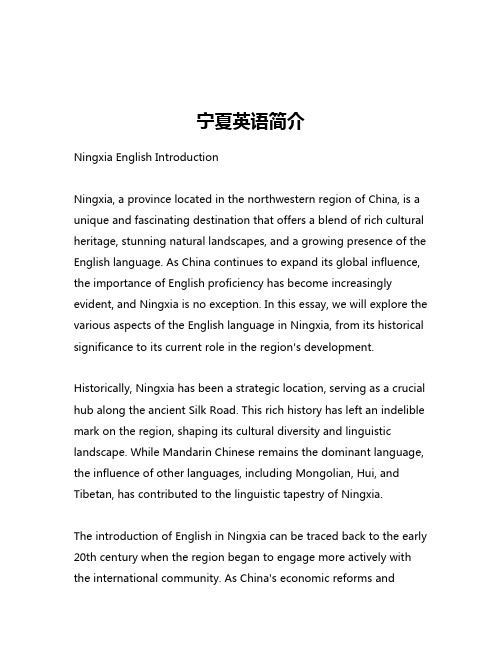
宁夏英语简介Ningxia English IntroductionNingxia, a province located in the northwestern region of China, is a unique and fascinating destination that offers a blend of rich cultural heritage, stunning natural landscapes, and a growing presence of the English language. As China continues to expand its global influence, the importance of English proficiency has become increasingly evident, and Ningxia is no exception. In this essay, we will explore the various aspects of the English language in Ningxia, from its historical significance to its current role in the region's development.Historically, Ningxia has been a strategic location, serving as a crucial hub along the ancient Silk Road. This rich history has left an indelible mark on the region, shaping its cultural diversity and linguistic landscape. While Mandarin Chinese remains the dominant language, the influence of other languages, including Mongolian, Hui, and Tibetan, has contributed to the linguistic tapestry of Ningxia.The introduction of English in Ningxia can be traced back to the early 20th century when the region began to engage more actively with the international community. As China's economic reforms andopening-up policies gained momentum in the late 1970s, the demand for English proficiency grew significantly. Ningxia, being a part of this national initiative, has been actively promoting the learning and use of English among its population.One of the most notable efforts in this regard is the establishment of English language education programs in Ningxia's schools and universities. From primary education to tertiary institutions, the region has placed a strong emphasis on English language instruction, ensuring that its students are equipped with the necessary skills to thrive in the global marketplace.In addition to the formal education system, Ningxia has also embraced various initiatives to enhance English language proficiency among its residents. Community-based language centers, language exchange programs, and English-speaking clubs have been set up to provide opportunities for people of all ages to practice and improve their English skills.The impact of these efforts can be seen in the increasing presence of English in Ningxia's public spaces and daily life. Signage in major cities and tourist attractions often features both Chinese and English, making it easier for foreign visitors to navigate and communicate. Furthermore, the hospitality industry, including hotels, restaurants, and tourist attractions, has made significant strides in providingEnglish-language services to cater to the growing number of international visitors.However, the journey towards widespread English proficiency in Ningxia is not without its challenges. The region's diverse linguistic landscape, with various dialects and minority languages, can sometimes create barriers to the effective dissemination of English. Additionally, the socioeconomic disparities within Ningxia can lead to uneven access to English language education, particularly in rural and less-developed areas.To address these challenges, the Ningxia government has implemented targeted initiatives to ensure that the benefits of English language education are distributed more evenly across the region. Scholarships, teacher training programs, and outreach efforts in remote communities have been instrumental in bridging the gap and providing equal opportunities for all Ningxia residents to acquire English language skills.As Ningxia continues to evolve and integrate with the global community, the role of the English language will become increasingly crucial. The region's efforts to promote English proficiency not only serve to enhance its economic and cultural exchange with the outside world but also contribute to the personal and professional development of its people.In conclusion, the introduction and growth of the English language in Ningxia represent a significant milestone in the region's journey towards greater international engagement and cooperation. Through its comprehensive educational initiatives, community-based programs, and strategic infrastructure development, Ningxia is paving the way for a future where English fluency becomes a valuable asset for its residents, enabling them to thrive in the ever-evolving global landscape.。
宁夏PPT英文介绍

Ningxia Hui Autonomous Region
• Ningxia Province
Yin Chuan
It was the capital of the Western Xia Dynasty and is now the capital of Ningxia. Yinchuan lies in the middle of the Yinchuan or Ningxia Plain. It is sheltered from the deserts of Mongolia by the high ranges of the Helan range to its west. The Yellow River runs through the area from southwest to northeast. The average elevation of Yinchuan is 1,100 meters.
Top attractions
Zhenbeibu China West Film Studio
Chinese movies march toward the world from here
The Western Xia Imperial Tombs (西夏王陵)
The Western Xia Imperial NingXia Province-YinChuan
• Ningxia Library
•
Ningxia Museum
Science and technology museum
• People's congress Standing Committee
With the Yellow River passing through the region, Ningxia enjoys a convenient irrigation system. Together with ample sunshine, Ningxia is one of China's major agricultural areas.
宁夏介绍(中英文版) PPT
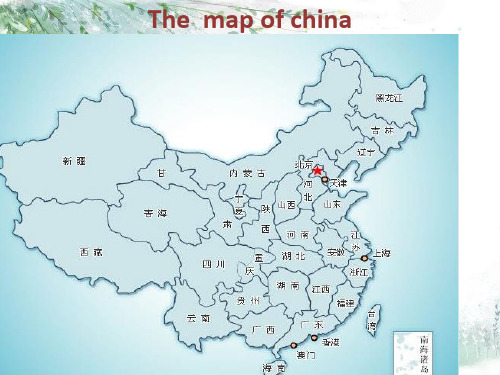
She also encouraged brave young men and women of the tribes (部族) to pursue their love and happiness . At last , the man was dead and Tan was cry day and night , she tears turned into a handsome shiny (晶莹 的)colored stone - Helan stone. 她还鼓励部族的青年男女勇敢的追求自己 的爱情和幸福。后来阿拿在抵御外族的侵 略中战死沙场。坦依· 贺兰守护在爱人的身 边日夜祈祷,流下的眼泪化作清秀晶莹的 彩色石头——贺兰石。
旱、半干旱的荒漠草原、沙漠边缘和黄土丘陵地带,被称为众药之王。)
• No 3 : The blue treasure ---------Helan stones(贺 兰石) Take Ningxia HeLan stone, you will get you love .
(人们将贺兰石称爱情石和吉祥石,并把
It is said that if someone can stack up seven Helan stones,he will won his lover. 传说如果有人能将七块贺兰 石叠起,就会遇到自己命中 注定的缘份。
No 4 : The white treasure --------Tanyangpi(滩羊皮) TanYangPi is soft, flexible, sleek , much is white, also have a few black, The main producing area of it is ningxia yinchuan , Yanchi , Zhongwei. (滩羊皮毛长,柔软,灵活,光润,毛色
英文版-宁夏概况 A Brief Introduction to Ningxia
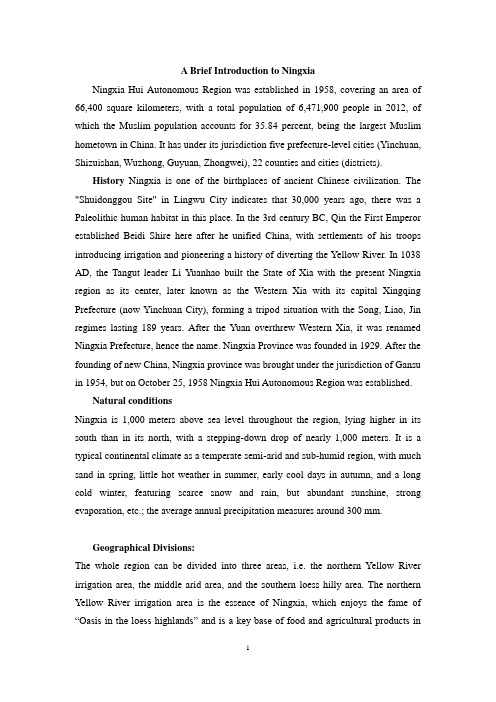
A Brief Introduction to NingxiaNingxia Hui Autonomous Region was established in 1958, covering an area of 66,400 square kilometers, with a total population of 6,471,900 people in 2012, of which the Muslim population accounts for 35.84 percent, being the largest Muslim hometown in China. It has under its jurisdiction five prefecture-level cities (Yinchuan, Shizuishan, Wuzhong, Guyuan, Zhongwei), 22 counties and cities (districts).History Ningxia is one of the birthplaces of ancient Chinese civilization. The "Shuidonggou Site" in Lingwu City indicates that 30,000 years ago, there was a Paleolithic human habitat in this place. In the 3rd century BC, Qin the First Emperor established Beidi Shire here after he unified China, with settlements of his troops introducing irrigation and pioneering a history of diverting the Yellow River. In 1038 AD, the Tangut leader Li Yuanhao built the State of Xia with the present Ningxia region as its center, later known as the Western Xia with its capital Xingqing Prefecture (now Yinchuan City), forming a tripod situation with the Song, Liao, Jin regimes lasting 189 years. After the Yuan overthrew Western Xia, it was renamed Ningxia Prefecture, hence the name. Ningxia Province was founded in 1929. After the founding of new China, Ningxia province was brought under the jurisdiction of Gansu in 1954, but on October 25, 1958 Ningxia Hui Autonomous Region was established.Natural conditionsNingxia is 1,000 meters above sea level throughout the region, lying higher in its south than in its north, with a stepping-down drop of nearly 1,000 meters. It is a typical continental climate as a temperate semi-arid and sub-humid region, with much sand in spring, little hot weather in summer, early cool days in autumn, and a long cold winter, featuring scarce snow and rain, but abundant sunshine, strong evaporation, etc.; the average annual precipitation measures around 300 mm.Geographical Divisions:The whole region can be divided into three areas, i.e. the northern Yellow River irrigation area, the middle arid area, and the southern loess hilly area. The northern Yellow River irrigation area is the essence of Ningxia, which enjoys the fame of “Oasis in the loess highlands” and is a key base of food and agricultural products inChina. The middle arid area is a desert or semi-desert zone ecologically. Surrounded by Tengri Desert, Ulan Buh Desert and Mu Us Desert, the middle arid area is dry without much rain, featuring poor living conditions, with windy, sandy weather and barren land. The southern mountainous area is covered with mountains and valleys and sparse vegetation, with severe water loss and soil erosion, and with part of the territory damp and cold. So it is a key area for China’s poverty alleviation work together with the middle arid area, with economic and social development lagging behind.Advantages in ResourcesNingxia boasts the comparative advantage of agriculture, energy and tourism, thus manifesting broad development prospects. First, the agricultural advantages. We have 1.107 million hectares of arable land, ranking No. 3 in China in terms of per-capita land, including 460,000 hectares with irrigation provided by the Yellow River, so it is one of China's 12 commodity grain production bases; we have 2.274 million hectares of pasture as one of the top ten pastoral areas. Second, the energy advantage. Four billion cubic meters of Yellow River water is available for us, accounting for about 10% of the total allocation; we have proven coal reserves of over 30 billion tons, ranking No. 6 in China. Ningdong Coalfield boasts 27.3 billion tons of proven reserves as one of the six huge mines to be developed as a national priority; we have 12 existing large and medium-sized power plants, with an annual generating capacity of 39.3 billion kilowatts-hour, or 6,550 kilowatts-hour per capita, ranking No.1 in China; with 50 kinds of proven mineral resources, the latent value of our natural resources per capita is 163.59 percent of the national average, ranking No. 5 in China. Third, tourism advantages. Ancient Yellow River civilization, the mysterious Western Xia history, rich folkways in Hui hometown style and magnificent desert scenery constitute a colorful variety of our unique tourist resources. Ningxia is trying to build itself up as an international tourist destination with unique West China characteristics.InfrastructureIn the region, there is a highway network stretching nearly 25,000 km, of which 1,323km is expressway, so that it takes only one hour for each city and county to reach the expressway. The region's administrative villages are all accessible by roads, electricity, telephone, radio and television. There are 35 various kinds of development zones and industrial parks, in which three are national-level development zones. These development zones have complete infrastructure, with prominent product features and comprehensive supporting functions, thus providing a big platform for adapting to industrial transfer.Two Major Strategies:Along the Yellow River, there are 10 cities in Ningxia. With more than 90% of Ningxia’s GDP and 94% of Ningxia’s fiscal revenue, it is an essential zone of Ningxia. The Ningxia Yellow River Economic Zone is one of the 18 main functional areas with key inputs from the central government, which has been written into the Outline of the "Twelfth Five-Year Plan" and become a national strategy. The Liupanshan Mountain area of Ningxia covers a vast land with a relatively big population and slow development. It is zo ned as a key point of China’s new round of poverty alleviation and development. To grasp these policy opportunities of the central government supporting Ningxia’s development, Ningxia proposes to vigorously carry out the two major strategies of Yellow River-front economic zone development and poverty alleviation for millions of poor people, so as to accelerate the construction of a harmonious and wealthy new Ningxia, and strive to realize the goal of an overall well-off society simultaneously with the other parts of China. This is not only a key point of economic and social development, but also a new opportunity for foreign investors in Ningxia.Construction of the Two Zones:In September 2012, China’s State Council approved the Ningxia Inland Opening-up Pilot Economic Zone and Yinchuan Comprehensive Bonded Zone. The Ningxia Inland Opening-up Pilot Economic Zone is the first and only pilot zone covering the whole region in inland China. It is oriented as “China’s strategic highland opening to the west, China’s important energy and chemical industry base, and China’s major industrial cluster of halal food and Muslim commodity as well as demonstration zoneof industrial transfer”. As one of the only three bonded zones in Northwest China, the Yinchuan Comprehensive Bonded Zone enjoys great preferential policies in terms of tax, trade regulations, bonded supervision, foreign exchange administration, etc. it will be built up as one of the special regulated areas with the highest opening-up level, the most preferential government policies, the most complete functions, the simplest procedures and the most prominent location advantages. The launching of the two zones’ not only is a major historic opportunity for Ningxia’s development, but also provides a new platform for China, Arab states and other Muslim regions to strengthen economic, trade and cultural exchange and cooperation, to adapt to global industrial transfer, to fully make use of international resources and market, and to expand the scale of the processing trade.Our achievementsIn recent years, Ningxia's socioeconomic cause embarked on a track of sustained, rapid and healthy development, and for 12 consecutive years our economic growth rate has surpassed the national average. With the reform and opening up in full swing, we have initial success in economic structural adjustment, witnessing significant changes in urban and rural areas, and people's living standards have been greatly improved. In 2012, we achieved GDP 232.664 billion yuan, up 11.5%; fiscal revenue 46.01 billion yuan, up 23.9%; the social investment of fixed assets 210.952 billion yuan, an increase of 27.5%; the total retail sales of consumer goods 54.88 billion yuan, up 14.9%; per capita disposable income of urban residents 19,831 yuan, an increase of 12.8%, rural per capita net income of 6,180 yuan, an increase of 14.2%.。
宁夏PPT英文介绍备课讲稿
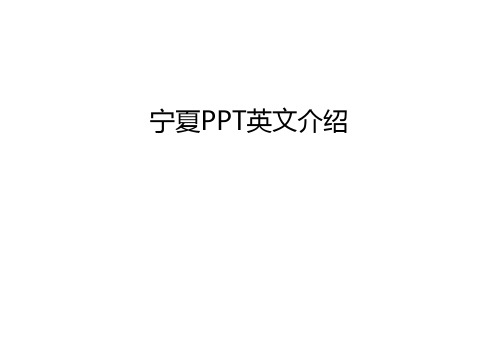
Top attractions
Zhenbeibu China West Film Studio
Chinese movies march toward the world from here
The Western Xia Imperial Tombs (西夏王陵)
The Western Xia Imperial Tombs
• The Yellow River runs through the area from southwest to northeast. The average elevation of Yinchuan is 1,100 meters.
Capital City of NingXia Province-YinChuan
• Ni
Science and technology museum
• People's congress Standing Committee
With the Yellow River passing through the region, Ningxia enjoys a convenient irrigation system. Together with ample sunshine, Ningxia is one of China's major agricultural areas.
• Known as the "Eastern Pyramids," the site includes nine imperial mausoleums and 250 tombs of imperial relatives and officials.
• The scenic spot is one of the largest and best preserved imperial mausoleums in China. In 1988, it is recognized as a key cultural heritage site under State protection and a national key scenic spot.
宁夏英语PPT介绍

Hui Culture
Koran
Mosque
costumes
Arabic
The main way of Hui people’s life is Islam, where live a higher concentration of mosques, also known as the Mosque imam preside over religious activities, classic Koran believers known as the "Muslim life and customs to keep the Muslim Tradition, follow the religious rules. pay attention to hygiene.
Zhenbeibu China West Film Studio
ቤተ መጻሕፍቲ ባይዱ
shapotou
People like calling it “ sing sand”because of making beautiful sound.
Sand ring is a unique natural phenomenon in the desert.When the sand is dry,down from the top of the dunes with sand ring conditions slippery,sand will be issued a lot of the machine.
My hometown
• The Ningxia Hui Autonomous region
Covering some 60,000 square kilometers, Ningxia is home to 6 million people. One third of the population are ethnic Hui minority
英语介绍宁夏

Xixia Tombs
The Western Xia tombs at the foot of the Helan Mountains in the Ningxia Hui Autonomous Region of northwestern China includes nine imperial mausoleums and 250 tombs of imperial relatives and officials. This burial complex lies some 40 km westward from capital city of the Western Xia, the Xingqing fu or Xingqing, what is modern-day Yinchuan, capital of Ningxia Hui Autonomous Region.
Governance
The politics of Ningxia is structured in a dual party-government system like all other governing institutions in mainland China. The Chairman of the Autonomous Region is the highest-ranking official in the People's Government of Ningxia. However, in the Autonomous Region's dual party-government governing system, the Chairman has less power than the Communist Party of China Ningxia Committee Secretary.
英文版-宁夏概况ABriefIntroductiontoNingxia

英文版-宁夏概况ABriefIntroductiontoNingxiaA Brief Introduction to NingxiaNingxia Hui Autonomous Region was established in 1958, covering an area of 66,400 square kilometers, with a total population of 6,471,900 people in 2012, of which the Muslim population accounts for 35.84 percent, being the largest Muslim hometown in China. It has under its jurisdiction five prefecture-level cities (Yinchuan, Shizuishan, Wuzhong, Guyuan, Zhongwei), 22 counties and cities (districts).History Ningxia is one of the birthplaces of ancient Chinese civilization. The "Shuidonggou Site" in Lingwu City indicates that 30,000 years ago, there was a Paleolithic human habitat in this place. In the 3rd century BC, Qin the First Emperor established Beidi Shire here after he unified China, with settlements of his troops introducing irrigation and pioneering a history of diverting the Yellow River. In 1038 AD, the Tangut leader Li Yuanhao built the State of Xia with the present Ningxia region as its center, later known as the Western Xia with its capital Xingqing Prefecture (now Yinchuan City), forming a tripod situation with the Song, Liao, Jin regimes lasting 189 years. After the Yuan overthrew Western Xia, it was renamed Ningxia Prefecture, hence the name. Ningxia Province was founded in 1929. After the founding of new China, Ningxia province was brought under the jurisdiction of Gansu in 1954, but on October 25, 1958 Ningxia Hui Autonomous Region was established.Natural conditionsNingxia is 1,000 meters above sea level throughout the region, lying higher in its south than in its north, with a stepping-down drop of nearly 1,000 meters. It is a typical continentalclimate as a temperate semi-arid and sub-humid region, with much sand in spring, little hot weather in summer, early cool days in autumn, and a long cold winter, featuring scarce snow and rain, but abundant sunshine, strong evaporation, etc.; the average annual precipitation measures around 300 mm.Geographical Divisions:The whole region can be divided into three areas, i.e. the northern Yellow River irrigation area, the middle arid area, and the southern loess hilly area. The northern Yellow River irrigation area is the essence of Ningxia, which enjoys the fa me of “Oasis in the loess highlands” and is a key base of food and agricultural products inChina. The middle arid area is a desert or semi-desert zone ecologically. Surrounded by Tengri Desert, Ulan Buh Desert and Mu Us Desert, the middle arid area is dry without much rain, featuring poor living conditions, with windy, sandy weather and barren land. The southern mountainous area is covered with mountains and valleys and sparse vegetation, with severe water loss and soil erosion, and with part of the territory damp and cold. So it is a key area for China’s poverty alleviation work together with the middle arid area, with economic and social development lagging behind.Advantages in ResourcesNingxia boasts the comparative advantage of agriculture, energy and tourism, thus manifesting broad development prospects. First, the agricultural advantages. We have 1.107 million hectares of arable land, ranking No. 3 in China in terms of per-capita land, including 460,000 hectares with irrigation provided by the Yellow River, so it is one of China's 12 commodity grain production bases; we have 2.274 million hectares of pastureas one of the top ten pastoral areas. Second, the energy advantage. Four billion cubic meters of Yellow River water is available for us, accounting for about 10% of the total allocation; we have proven coal reserves of over 30 billion tons, ranking No.6 in China. Ningdong Coalfield boasts 27.3 billion tons of proven reserves as one of the six huge mines to be developed as a national priority; we have 12 existing large and medium-sized power plants, with an annual generating capacity of 39.3 billion kilowatts-hour, or 6,550 kilowatts-hour per capita, ranking No.1 in China; with 50 kinds of proven mineral resources, the latent value of our natural resources per capita is 163.59 percent of the national average, ranking No. 5 in China. Third, tourism advantages. Ancient Yellow River civilization, the mysterious Western Xia history, rich folkways in Hui hometown style and magnificent desert scenery constitute a colorful variety of our unique tourist resources. Ningxia is trying to build itself up as an international tourist destination with unique West China characteristics.InfrastructureIn the region, there is a highway network stretching nearly 25,000 km, of which 1,323km is expressway, so that it takes only one hour for each city and county to reach the expressway. The region's administrative villages are all accessible by roads, electricity, telephone, radio and television. There are 35 various kinds of development zones and industrial parks, in which three are national-level development zones. These development zones have complete infrastructure, with prominent product features and comprehensive supporting functions, thus providing a big platform for adapting to industrial transfer.Two Major Strategies:Along the Yellow River, there are 10 cities in Ningxia. With more than 90% of Ningxia’s GDP and 94% of Ningxia’s fiscal revenue, it is an essential zone of Ningxia. The Ningxia Yellow River Economic Zone is one of the 18 main functional areas with key inputs from the central government, which has been written into the Outline of the "Twelfth Five-Year Plan" and become a national strategy. The Liupanshan Mountain area of Ningxia covers a vast land with a relatively big population and slow development. It is zo ned as a key point of China’s new round of poverty alleviation and development. To grasp these policy opportunities of the central government supporting Ningxia’s development, Ningxia proposes to vigorously carry out the two major strategies of Yellow River-front economic zone development and poverty alleviation for millions of poor people, so as to accelerate the construction of a harmonious and wealthy new Ningxia, and strive to realize the goal of an overall well-off society simultaneously with the other parts of China. This is not only a key point of economic and social development, but also a new opportunity for foreign investors in Ningxia.Construction of the Two Zones:In September 2012, China’s State Council approved the Ningxia Inland Opening-up Pilot Economic Zone and Yinchuan Comprehensive Bonded Zone. The Ningxia Inland Opening-up Pilot Economic Zone is the first and only pilot zone covering the whole region in inland China. It is ori ented as “China’s strategic highland opening to the west, China’s important energy and chemical industry base, and China’s major industrial cluster of halal food and Muslim commodity as well as demonstration zone of industrial transfer”. As one of the only three bondedzones in Northwest China, the Yinchuan Comprehensive Bonded Zone enjoys great preferential policies in terms of tax, trade regulations, bonded supervision, foreign exchange administration, etc. it will be built up as one of the special regulated areas with the highest opening-up level, the most preferential government policies, the most complete functions, the simplest procedures and the most prominent location advantages. The launching of the two zones’ not only is a major historic opportunit y for Ningxia’s development, but also provides a new platform for China, Arab states and other Muslim regions to strengthen economic, trade and cultural exchange and cooperation, to adapt to global industrial transfer, to fully make use of international resources and market, and to expand the scale of the processing trade.Our achievementsIn recent years, Ningxia's socioeconomic cause embarked on a track of sustained, rapid and healthy development, and for 12 consecutive years our economic growth rate has surpassed the national average. With the reform and opening up in full swing, we have initial success in economic structural adjustment, witnessing significant changes in urban and rural areas, and people's living standards have been greatly improved. In 2012, we achieved GDP 232.664 billion yuan, up 11.5%; fiscal revenue 46.01 billion yuan, up 23.9%; the social investment of fixed assets 210.952 billion yuan, an increase of 27.5%; the total retail sales of consumer goods 54.88 billion yuan, up 14.9%; per capita disposable income of urban residents 19,831 yuan, an increase of 12.8%, rural per capita net income of 6,180 yuan, an increase of 14.2%.。
我的家乡英文介绍之宁夏
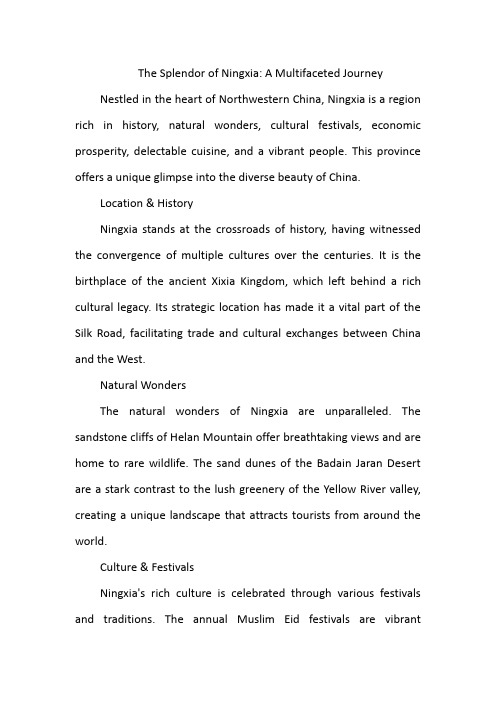
The Splendor of Ningxia: A Multifaceted Journey Nestled in the heart of Northwestern China, Ningxia is a region rich in history, natural wonders, cultural festivals, economic prosperity, delectable cuisine, and a vibrant people. This province offers a unique glimpse into the diverse beauty of China.Location & HistoryNingxia stands at the crossroads of history, having witnessed the convergence of multiple cultures over the centuries. It is the birthplace of the ancient Xixia Kingdom, which left behind a rich cultural legacy. Its strategic location has made it a vital part of the Silk Road, facilitating trade and cultural exchanges between China and the West.Natural WondersThe natural wonders of Ningxia are unparalleled. The sandstone cliffs of Helan Mountain offer breathtaking views and are home to rare wildlife. The sand dunes of the Badain Jaran Desert are a stark contrast to the lush greenery of the Yellow River valley, creating a unique landscape that attracts tourists from around the world.Culture & FestivalsNingxia's rich culture is celebrated through various festivals and traditions. The annual Muslim Eid festivals are vibrantcelebrations, filled with colorful parades, delicious food, and community gatherings. Additionally, the local Hui culture, which blends Chinese and Islamic traditions, has given Ningxia a unique cultural identity.Economy & DevelopmentIn recent years, Ningxia has undergone rapid economic development. Its agricultural sector, which produces high-quality fruits, vegetables, and livestock, has become a major contributor to the province's GDP. Additionally, Ningxia's strategic location has attracted numerous investors in the renewable energy and technology sectors, fueling further economic growth.Food & CuisineNingxia's cuisine is a fusion of local flavors and influences from its neighboring regions. The local delicacies, such as mutton skewers, hand-pulled noodles, and lamb stew, are popular not only in Ningxia but throughout China. The unique Hui cuisine, with its emphasis on lamb and beef dishes, is a must-try for food lovers.People & SocietyThe people of Ningxia are warm, welcoming, and deeply rooted in their culture. They value family, community, and harmony, which is reflected in their daily lives and social interactions. The province's society is also vibrant and dynamic, with a growing youthpopulation that is actively contributing to the economic and cultural development of Ningxia.In conclusion, Ningxia is a province that embodies the essence of China's diverse beauty and cultural heritage. Its strategic location, natural wonders, cultural festivals, economic prosperity, delicious cuisine, and vibrant people make it a must-visit destination for anyone interested in experiencing the true essence of China.。
宁夏英文介绍
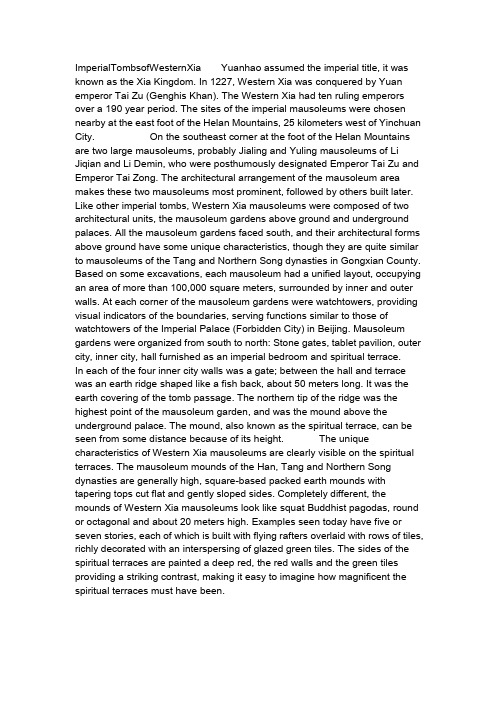
ImperialTombsofWesternXia Yuanhao assumed the imperial title, it was known as the Xia Kingdom. In 1227, Western Xia was conquered by Yuan emperor Tai Zu (Genghis Khan). The Western Xia had ten ruling emperors over a 190 year period. The sites of the imperial mausoleums were chosen nearby at the east foot of the Helan Mountains, 25 kilometers west of Yinchuan City. On the southeast corner at the foot of the Helan Mountains are two large mausoleums, probably Jialing and Yuling mausoleums of Li Jiqian and Li Demin, who were posthumously designated Emperor Tai Zu and Emperor Tai Zong. The architectural arrangement of the mausoleum area makes these two mausoleums most prominent, followed by others built later. Like other imperial tombs, Western Xia mausoleums were composed of two architectural units, the mausoleum gardens above ground and underground palaces. All the mausoleum gardens faced south, and their architectural forms above ground have some unique characteristics, though they are quite similar to mausoleums of the Tang and Northern Song dynasties in Gongxian County. Based on some excavations, each mausoleum had a unified layout, occupying an area of more than 100,000 square meters, surrounded by inner and outer walls. At each corner of the mausoleum gardens were watchtowers, providing visual indicators of the boundaries, serving functions similar to those of watchtowers of the Imperial Palace (Forbidden City) in Beijing. Mausoleum gardens were organized from south to north: Stone gates, tablet pavilion, outer city, inner city, hall furnished as an imperial bedroom and spiritual terrace.In each of the four inner city walls was a gate; between the hall and terrace was an earth ridge shaped like a fish back, about 50 meters long. It was the earth covering of the tomb passage. The northern tip of the ridge was the highest point of the mausoleum garden, and was the mound above the underground palace. The mound, also known as the spiritual terrace, can be seen from some distance because of its height. The unique characteristics of Western Xia mausoleums are clearly visible on the spiritual terraces. The mausoleum mounds of the Han, Tang and Northern Song dynasties are generally high, square-based packed earth mounds with tapering tops cut flat and gently sloped sides. Completely different, the mounds of Western Xia mausoleums look like squat Buddhist pagodas, round or octagonal and about 20 meters high. Examples seen today have five or seven stories, each of which is built with flying rafters overlaid with rows of tiles, richly decorated with an interspersing of glazed green tiles. The sides of the spiritual terraces are painted a deep red, the red walls and the green tiles providing a striking contrast, making it easy to imagine how magnificent the spiritual terraces must have been.。
- 1、下载文档前请自行甄别文档内容的完整性,平台不提供额外的编辑、内容补充、找答案等附加服务。
- 2、"仅部分预览"的文档,不可在线预览部分如存在完整性等问题,可反馈申请退款(可完整预览的文档不适用该条件!)。
- 3、如文档侵犯您的权益,请联系客服反馈,我们会尽快为您处理(人工客服工作时间:9:00-18:30)。
蓝宝--贺兰石The blue treasure –Helan stones
It is said that there was a princess whose name is Helan, she is beautiful and kindhearted. Despite others opposition, she married with a warrior whose identity was low. later on, her husband died of war. she guarded her husband all the time and prayed day and night,her tears turned into shiny and color stones--Helan stones.Under a sense of love move,her husband was finally back to life, Since then, they lived a happy life.
The map of China
宁夏
The map of Ningxia
Welcome to Ningxia
宁夏五宝 Five treasures of Ningxia
宁夏景点 The scenic of Ningxia
红宝—枸杞
红宝—枸杞 The red treasure --Gouqi
– is a rare traditional Gouqi枸杞是一种名贵中药, 营养成份十分丰富,并 Chinese medicine, very 有很高的药物价值 rich in nutrients,makes a great difference on lungs, liver,eyes and bones.
黄宝--甘草 The yellow treasure --Licorice
Licorice like to grow in dry climate and cold region which can used to conserve soil and water. It is also a Chinese traditional medcial which can detoxification(清热解毒) and expectorant cough (祛痰止咳).
白宝--滩羊皮The white treasure--Tanyangpe
It is used to make clothes which is light, warm, comfortable, beautiful and Elegant.
黑宝—发菜The black treasure
Facai is belong to Cyanophyta(蓝藻门), its pronouncation is similar to facai(发财), so people like it very much. Facai grow in desert and barren soil, then it become the State-level key protected wild plants Ⅰ
--Facai
中华回乡文化园 Chinese hui’s cultural park
银川鸣翠湖国家湿地公园
Ming cui lake national wetland park in Yinchuan
沙坡头 sand slope
